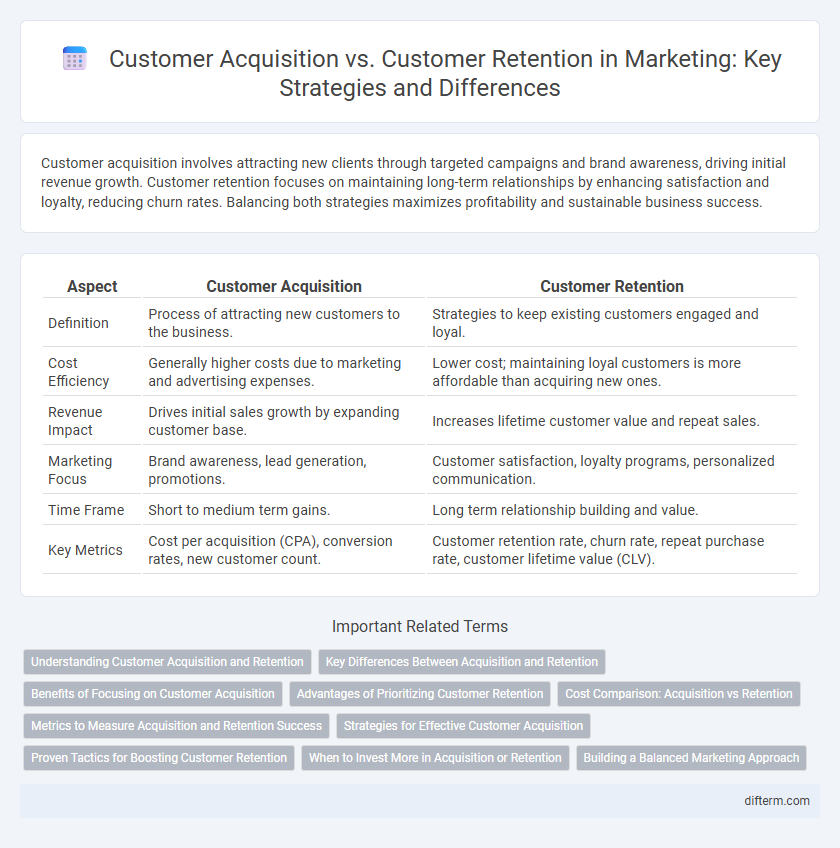Customer acquisition involves attracting new clients through targeted campaigns and brand awareness, driving initial revenue growth. Customer retention focuses on maintaining long-term relationships by enhancing satisfaction and loyalty, reducing churn rates. Balancing both strategies maximizes profitability and sustainable business success.
Table of Comparison
| Aspect | Customer Acquisition | Customer Retention |
|---|---|---|
| Definition | Process of attracting new customers to the business. | Strategies to keep existing customers engaged and loyal. |
| Cost Efficiency | Generally higher costs due to marketing and advertising expenses. | Lower cost; maintaining loyal customers is more affordable than acquiring new ones. |
| Revenue Impact | Drives initial sales growth by expanding customer base. | Increases lifetime customer value and repeat sales. |
| Marketing Focus | Brand awareness, lead generation, promotions. | Customer satisfaction, loyalty programs, personalized communication. |
| Time Frame | Short to medium term gains. | Long term relationship building and value. |
| Key Metrics | Cost per acquisition (CPA), conversion rates, new customer count. | Customer retention rate, churn rate, repeat purchase rate, customer lifetime value (CLV). |
Understanding Customer Acquisition and Retention
Understanding customer acquisition involves targeting new prospects through tailored marketing strategies and effective lead generation to expand market reach. Customer retention emphasizes nurturing existing relationships by delivering exceptional value, personalized experiences, and consistent engagement to increase lifetime customer value. Balancing acquisition and retention optimizes overall growth by reducing churn rates and maximizing return on marketing investment.
Key Differences Between Acquisition and Retention
Customer acquisition focuses on attracting new customers through targeted campaigns and lead generation, often incurring higher costs per conversion. In contrast, customer retention emphasizes maintaining relationships with existing clients, leveraging loyalty programs and personalized communication to increase lifetime value and reduce churn. The key differences lie in objectives, cost efficiency, and strategies, where acquisition drives growth while retention maximizes profitability through customer satisfaction.
Benefits of Focusing on Customer Acquisition
Customer acquisition drives business growth by expanding the customer base and increasing market share, which directly boosts revenue potential. Investing in targeted acquisition strategies allows companies to tap into new demographics and diversify their audience reach. Effective acquisition efforts also enhance brand awareness and generate valuable data for refining marketing campaigns and product development.
Advantages of Prioritizing Customer Retention
Prioritizing customer retention leads to increased lifetime value, as repeat customers typically spend 67% more than new ones. Retained customers also generate higher profit margins with acquisition costs being 5 to 25 times more expensive than retention efforts. Focusing on retention enhances brand loyalty and referral rates, significantly boosting organic growth and long-term revenue stability.
Cost Comparison: Acquisition vs Retention
Customer acquisition costs are typically five to seven times higher than customer retention expenses, making retention a more cost-effective strategy. Retaining customers increases lifetime value and reduces marketing spend associated with onboarding new clients. Investing in retention programs can yield up to 25-95% higher profitability compared to acquisition-focused campaigns.
Metrics to Measure Acquisition and Retention Success
Customer acquisition metrics include Customer Acquisition Cost (CAC), Conversion Rate, and Time to First Purchase, which quantify the efficiency and speed of gaining new clients. Customer retention success is best measured by metrics like Customer Lifetime Value (CLV), Churn Rate, and Repeat Purchase Rate, highlighting the long-term value and loyalty of existing customers. Tracking these specific KPIs allows marketers to optimize strategies, balancing expenditure between attracting new customers and nurturing existing relationships for sustainable growth.
Strategies for Effective Customer Acquisition
Targeted digital advertising and personalized content marketing drive high-quality customer acquisition by addressing specific audience needs and behaviors. Utilizing data analytics enables businesses to identify and optimize the most cost-effective acquisition channels, increasing conversion rates and reducing customer acquisition cost (CAC). Building strategic partnerships and referral programs amplifies reach and credibility, accelerating trust and engagement with potential customers.
Proven Tactics for Boosting Customer Retention
Proven tactics for boosting customer retention include personalized communication, loyalty programs, and exceptional customer service, which collectively increase lifetime value and reduce churn rates. Data-driven segmentation allows marketers to tailor offers and content, fostering stronger emotional connections and brand loyalty. Implementing feedback loops and proactive support further enhances customer satisfaction, encouraging repeat business and referrals.
When to Invest More in Acquisition or Retention
Invest more in customer acquisition when entering new markets or launching innovative products, as attracting fresh leads expands brand awareness and revenue potential. Prioritize customer retention during periods of market saturation or high competition, since loyal customers generate higher lifetime value and reduce overall marketing costs. Balancing acquisition and retention investments based on business goals and customer lifecycle data maximizes sustainable growth and profitability.
Building a Balanced Marketing Approach
Effective marketing balances customer acquisition and customer retention by optimizing resource allocation to attract new prospects while nurturing existing clients. Data-driven strategies leverage customer lifetime value (CLV) metrics to prioritize retention efforts, reducing churn rates and increasing profitability. Integrating personalized content, targeted campaigns, and loyalty programs enhances engagement across the customer journey, fostering sustainable business growth.
customer acquisition vs customer retention Infographic

 difterm.com
difterm.com